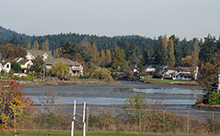
The Kosampson people, whose descendants are part of the Esquimalt Nation, lived in a village on the east bank of the Gorge, near Portage Inlet. Shell middens near Gorge Bridge confirm the area has been used for over 4,000 years. Portage Inlet continues to be culturally significant areas for the Esquimalt and Songhees peoples.
The Craigflower schoolhouse was built on the former Kosampson village site in 1854, and still stands today as part of the Craigflower Manor and Schoolhouse National Historic Site, representing the last remaining sections of one of the oldest farms on Vancouver Island. Craigflower Farm was eventually owned by the Hudson’s Bay Company, and at the height of its operation the farm had dozens of people living there operating the saw mill, flour mill, blacksmith’s shop and other associated enterprises. Other farms were soon established in the surrounding areas.
In the late 1800s and early 1900s, Portage Inlet was a popular recreation and camping area for residents of Victoria. Many types of boats including First Nations canoes, sternwheelers and rowboats plied the waters of Portage Inlet over the past 100 years.
As Victoria expanded, residential properties took over the woods and agricultural fields surrounding the inlet. Many shoreline areas have been modified with seawalls and wharves. As in the Gorge Waterway, sewage pollution became a problem and swimming was eventually banned. This trend has reversed in recent years, and today there are low levels of fecal and chemical contamination found in Portage Inlet waters.
Local parks along Portage Inlet and natural shores such as the rocky shoreline on Christie Point provide valuable habitat for wildlife, birds and plants and opportunities for people to enjoy the natural beauty of the inlet.